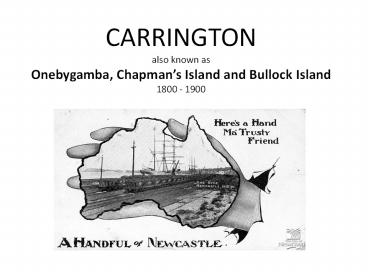Carrington - PowerPoint PPT Presentation
Title:
Carrington
Description:
3H were given the task of researching a place from early Newcastle or a person of significance to Newcastle. If they chose to research a person they had to find information about their full name, a picture if possible, where they were born, how and why they came to Newcastle, some of the events in their life and their significance to Newcastle. If they chose to reasearch a place they had to find information about its name, how it come to be, where is it, what it was used for and how it has or its uses have changed over time? – PowerPoint PPT presentation
Number of Views:87
Slides: 9
Provided by:
Username withheld or not provided
Category:
How To, Education & Training
Tags:
Title: Carrington
1
CARRINGTONalso known asOnebygamba, Chapmans
Island and Bullock Island1800 - 1900
2
Carrington - The Early Days
- Carrington was originally known by the aboriginal
name Onebygamba meaning large mound. - The earliest European visitors to the Hunter
river described the area as a mud flat mostly dry
at low tide. - In 1804 the area was identified for reclamation.
The island by this time was known as Chapman's
Island. - A branch of the river named Throsby creek
separated the mud flats from the main land to the
west now known as Wickham.
3
- The creek was named after surgeon Charles Throsby
who was the 3rd commandant of the Newcastle penal
settlement between 1805 and 1809. - By the 1850s rock ballast was dumped from sailing
ships and built up the eastern side of the island
forming an embankment or dyke. Ships could load
or unload cargo here. - By 1865 the island was know known as Bullock
Island. - In 1887 Bullock Island became a municipality
named after Lord Carrington who was governor of
NSW from 1885 to 1890.
4
The Dyke end as it is now known which was built
up during the 1850s was now a series of wharves
and fitted with cranes which were powered by a
hydraulic power station built in 1877, which
still stands today.Carrington Hydraulic Power
station built in 1877
5
The long wharves became Newcastle's exporting
wharves for coal and freight. Sail and steam
ships came from many parts of the world.
6
The first council meeting was held on Carrington
on the 1st June 1888. The population according to
the 1891 census was 450 residents but by 1900 had
reached 2200!Carrington Council Chambers built
in 1888
7
Coal Loading at the Dyke 1897
8
By Lewis Stewart 3H
- Of Carrington it can truly be said in its
construction, material from all parts of the
world have found a resting place - The Federal Directory of Newcastle and District
for 1901































